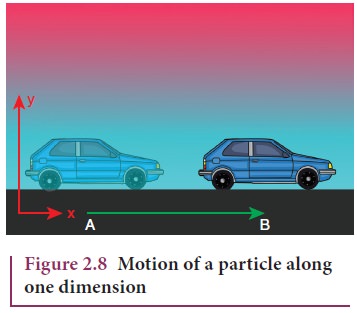Chapter: 11th Physics : UNIT 2 : Kinematics
Motion in One, Two and Three Dimensions
Motion
in One, Two and Three Dimensions
Let
the position of a particle in space be expressed in terms of rectangular
coordinates x, y and z. When these coordinates change with time, then the
particle is said to be in motion. However, it is not necessary that all the
three coordinates should together change with time. Even if one or two coordinates
changes with time, the particle is said to be in motion. Then we have the
following classification.
i. Motion in one dimension
One dimensional motion is the motion
of a particle moving along a straight line.
This
motion is sometimes known as rectilinear or linear motion.
In
this motion, only one of the three rectangular coordinates specifying the
position of the object changes with time.
For
example, if a car moves from position A to position B along x-direction, as shown in Figure 2.8,
then the variation in x-coordinate alone is noticed.

Examples
·
Motion
of a train along a straight railway track.
·
An
object falling freely under gravity close to Earth.
ii. Motion in two dimensions
If a particle is moving along a
curved path in a plane, then it is said to be in two dimensional motion.
In
this motion, two of the three rectangular coordinates specifying the position
of object change with time.
For
instance, when a particle is moving in the y
- z plane, x does not vary, but y
and z vary as shown in Figure 2.9

Examples
·
Motion
of a coin on a carrom board.
·
An
insect crawling over the floor of a room.
iii. Motion in three dimensions
A particle moving in usual three
dimensional space has three dimensional motion.
In
this motion, all the three coordinates specifying the position of an object
change with respect to time. When a particle moves in three dimensions, all the
three coordinates x, y and z will vary.
Examples
·
A
bird flying in the sky.
·
Random
motion of a gas molecule.
·
Flying
of a kite on a windy day.
Related Topics